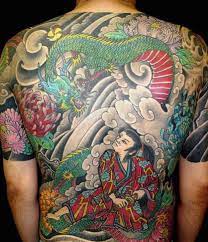
Irezumi, which is traditional Japanese tattooing, has a strong association with the Yakuza. This tattooing was used to identify criminals and make it difficult for them to reintegrate into society or find employment. Tattooing became a part of the Yakuza’s signature style as a form of resistance against organization and jobs. Over time, the Yakuza developed their body art as a means of resistance.
The Yakuza members prefer tiger tattoos, symbolizing protection from lousy fortune, diseases, and devils. Tigers also represent strength and courage. Yakuza tattoos often incorporate motifs like fierce lions and dragons to represent power and danger.
Bushido
Bushido is an ancient Japanese warrior culture that still holds influence today. The principles of bushido include honor, loyalty to family, friends, and country, self-control, a positive outlook towards others, and respect for nature. These ideals are influenced by Confucian principles of social behavior and Zen-Buddhist teachings.
Tattoo designs used by the Yakuza reflect these themes, such as foo dogs symbolizing protection and koi fish symbolizing strength and perseverance. Tigers are also a popular motif representing power and courage. Some Tattoos combine elements like fierce lions and dragons to represent power and danger within Yakuza tattoos.
Sakura
The Sakura flower, also known as cherry blossom, is a profound symbol in Japan. It represents beauty, life, mortality, and fleeting moments. Getting a tattoo of Sakura serves as a reminder to cherish each moment in life. Koi fish tattoos, often combined with dragons, represent strength, balance, power, and the ability to persevere through difficult times. Cherry blossom tattoos are delicate and feminine, making them popular among women, with the option to add other designs to personalize and showcase an affinity for Japanese culture.
Dragons
Dragons hold a special place in Japanese culture and art, making them a fitting symbol to represent power, strength, and protection. Yakuza members, who live dangerous lives full of risks, often choose dragon Tattoos to reflect this symbolism.
Tigers
Tigers are another popular choice for Yakuza tattoos, representing strength, dominance, and fearlessness. Yakuza members need these characteristics to assert their influence and authority within their factions.
Phoenix
The Phoenix symbolizes renewal and resurrection, symbolizing life through its short lifespan and transience. Yakuza members may choose Phoenix tattoos to signify rebirth, renewal, loyalty, and courage.
Octopus
Octopus Tattoos are famous among Yakuza members, symbolizing intelligence and adaptability. These traits reflect their criminal underworld tactics. Doing Yakuza tattoos takes longer as Hiroshi tattoo artists use traditional methods without electrical equipment.
Koi
In the 19th century, Japan aimed to shape its national image and avoid colonization, leading to the outlawing of “barbaric practices” like tattooing. In response, Yakuza members used Tattoos as identity markers and to honor their gang’s rank and status. Tattooing a koi fish symbolizes perseverance and the ability to overcome challenges. It also pays homage to an ancient tale of a carp battling waterfalls for decades and transforming into a dragon.
Balance Between Good and Evil
Yakuza members use Tattoos to represent the balance between good and evil and signal their intent to defend communities against devilish activities. Onis, depicted with massive bodies, red or blue skin tones, white hair, spiked clubs, and the ability to shapeshift, are commonly illustrated in these tattoos.
